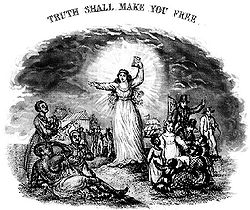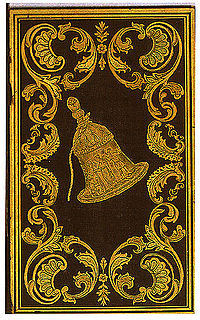.gif)
The Liberty Bell (annual)
Encyclopedia

Gift book
Gift books, literary annuals or a keepsake, were 19th century books, often lavishly decorated, which collected essays, short fiction, and poetry. They were primarily published in the autumn, in time for the holiday season and were intended to be given away rather than read by the purchaser...
, edited and published by Maria Weston Chapman
Maria Weston Chapman
Maria Weston or Maria Weston Chapman was an American abolitionist. She was elected to the executive committee of the American Anti-Slavery Society in 1839 and from 1839 until 1842, she served as editor of the anti-slavery journal, Non-Resistant.-Family:Weston was born in 1806 in Weymouth,...
, to be sold or gifted to participants in the National Anti-Slavery Bazaar organized by the Boston Female Anti-Slavery Society
Boston Female Anti-Slavery Society
The Boston Female Anti-Slavery Society was an abolitionist, interracial organization in Boston, Massachusetts, in the mid-19th century. "During its brief history .....
. It was published nearly every year from 1839 to 1858.
Background
In 1834 Maria Chapman of Boston, Massachusetts, her sisters Caroline, Anne, Deborah, and eight other women formed the Boston Female Anti-Slavery Society as part of their abolitionist activities. The Anti-Slavery Fair, first held in Boston in 1834, was a way to raise money for the society's work. Maria and her sister Anne were chief organizers of the fairs, which were popular Boston social events.The fairs organizers raised thousands of dollars a year by selling things such as "ladies' aprons, cloaks, cuffs, bags, purses," "knitted quilts," "inkstands," "Ohio cheese," and "dolls in hundreds of every size, price, material, and costume." In 1839 these items were joined by The Liberty Bell, modeled after the fashionable and popular gift book
Gift book
Gift books, literary annuals or a keepsake, were 19th century books, often lavishly decorated, which collected essays, short fiction, and poetry. They were primarily published in the autumn, in time for the holiday season and were intended to be given away rather than read by the purchaser...
s of the time. The book was sold to fair attendees and given without cost to the fair workers, as an acknowledgement of contribution to the abolitionist cause and token of the occasion. Publication continued every year until 1846, and intermittently until 1859's edition, produced in 1858. (1840, 1850, 1855, and 1857 were missed) As with many gift books, publication actually occurred late in the year prior to the date of the book, except for the very first (1839) edition. The next edition was thus dated 1841.
Content

Wendell Phillips
Wendell Phillips was an American abolitionist, advocate for Native Americans, and orator. He was an exceptional orator and agitator, advocate and lawyer, writer and debater.-Education:...
, Henry Wadsworth Longfellow
Henry Wadsworth Longfellow
Henry Wadsworth Longfellow was an American poet and educator whose works include "Paul Revere's Ride", The Song of Hiawatha, and Evangeline...
, James Russell Lowell
James Russell Lowell
James Russell Lowell was an American Romantic poet, critic, editor, and diplomat. He is associated with the Fireside Poets, a group of New England writers who were among the first American poets who rivaled the popularity of British poets...
, Lucretia Mott
Lucretia Mott
Lucretia Coffin Mott was an American Quaker, abolitionist, social reformer, and proponent of women's rights.- Early life and education:...
William Lloyd Garrison
William Lloyd Garrison
William Lloyd Garrison was a prominent American abolitionist, journalist, and social reformer. He is best known as the editor of the abolitionist newspaper The Liberator, and as one of the founders of the American Anti-Slavery Society, he promoted "immediate emancipation" of slaves in the United...
and Harriet Martineau
Harriet Martineau
Harriet Martineau was an English social theorist and Whig writer, often cited as the first female sociologist....
, among them many of the leading abolitionist, or abolitionist sympathizing writers of New England.
Chapman, in 1848, commented:
The purpose of this little annual volume, commenced in 1839, and now published for the ninth time, is, the promotion of the cause through the promulgation of its principles in an attractive form....Hence it is that no mere indifferent literati, however intellectually gifted, nor any known enemies of the cause or of its advocates, have ever been permitted to occupy these pages?
Her efforts at soliciting wider afield were successful as well, the Liberty Bell twice published works by Elizabeth Barrett Browning
Elizabeth Barrett Browning
Elizabeth Barrett Browning was one of the most prominent poets of the Victorian era. Her poetry was widely popular in both England and the United States during her lifetime. A collection of her last poems was published by her husband, Robert Browning, shortly after her death.-Early life:Members...
. The Runaway Slave at Pilgrim's Point was published in December 1847 for the 1848 edition, and A Curse for a Nation in December 1855 for the 1856 edition. Both of these works were later published in England as slightly different versions.
Unlike the more customary practice of writing for pay with more commercial gift books, authors typically did not receive any compensation for their submissions to the publication aside from a copy of The Liberty Bell itself.
Critical review
Accounts differ as to the success and quality of the annual. Some derided the quality of the works, one scholar (Ralph Thompson) saying "throughout the fifteen volumes of the series there is hardly to be found one creation of aesthetic value" while others felt the work was adequate, another scholar (Clare Taylor) saying "a good magazine .... Its standards were high, and items were convincing, for the anti-slavery movement relied on propaganda to win support" Views of the effectiveness of the material as propaganda also vary, Thompson saying "like all unadulterated reform literature, the Liberty Bell circulated among those people who already knew and accepted the tenets it upheld... it could hardly have made many converts", while Taylor feels that "From the outset the Liberty Bell was the most significant anti-slavery annual in America" and that it "made a real contribution to the anti-slavery movement". But even Taylor disparages "sentimental tales of terror which filled every issue"(96), and the "silly sensationalism" of many of the pieces, concluding that "their methods were crude and simplistic, even if their intentions were good" Taylor rates the two contributions by Elizabeth Barrett Browning as the best.Further reading
External links
- Chronological table of contents of the 15 volumes, at the website of Bucknell UniversityBucknell UniversityBucknell University is a private liberal arts university located alongside the West Branch Susquehanna River in the rolling countryside of Central Pennsylvania in the town of Lewisburg, 30 miles southeast of Williamsport and 60 miles north of Harrisburg. The university consists of the College of...
, edited by Glynis Carr - Gallery of illustrations, same source
- Selection of writings by Lydia Maria Child, same source

